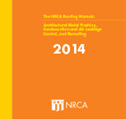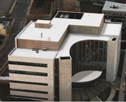For many years, NRCA has conducted periodic market surveys to provide industry professionals with data to compare industry market statistics, trends and information. The 2012-13 NRCA Market Survey includes the latest information about overall sales volume trends, roofing experience and material usage, and regional breakdowns, along with sales of types of roof systems for low- and steep-slope new construction, reroofing, repair and maintenance work. This data can help predict what is to come in the industry and identify trends.
Background
To gather the data for the market survey, NRCA mailed survey questionnaires to about 2,900 NRCA member roofing contractors at the end of 2011 to obtain data for experiences in 2012 and members' predictions for 2013. NRCA received 170 responses for a 6 percent response rate; the market survey should not be considered a statistically valid analysis of the U.S. roofing industry as it only is a summary of feedback from contractors with respect to sales volumes trends and the types of roof systems installed, repaired and maintained.
Not all questions were completed in each questionnaire, and some figures also were rounded, resulting in not every category totaling 100 percent. The data were collected from 10 U.S. regions: New England; Mid-Atlantic; South Atlantic; East North Central; East South Central; West North Central; West South Central; Mountain; Pacific; and Alaska, Hawaii and Puerto Rico (see "Regional divisions," page 54).
Market sales and forecasts
Overall, annual sales volumes for 2012 and 2013 averaged $5,165,737 and $5,546,529, respectively; this is compared with the 2011-12 market survey, reporting $5,895,608 and $5,299,583, respectively for the years surveyed. Sales volumes in the Alaska, Hawaii and Puerto Rico region fared best, with an average of $12 million in 2012 and $12 million in projected sales for 2013; this is compared with the lowest average annual sales volume in the West South Central region with $2,574,000 for 2012 and $2,948,000 projected for 2013.
Low-slope results
Low-slope roofing had a slightly lower percentage of work in the 2012-13 market survey than the 2011-12 results with 61.35 percent versus 62.72 percent. New construction increased slightly and reroofing decreased slightly in low-slope roofing compared with the 2011-12 survey. For 2012, participants averaged 19 percent of low-slope work for new construction, 66 percent for reroofing, and 15 percent for repair and maintenance work. In 2011, the figures were 16 percent of low-slope work for new construction, 70 percent for reroofing, and 14 percent for repair and maintenance work.
Steep-slope measurements
Steep-slope roofing work showed a slightly higher percentage of work in 2012-13 with 38.65 percent compared with the 2011-12 results of 36.14 percent. According to survey participants, steep-slope new construction work averaged 15 percent, reroofing averaged 69 percent, and repair and maintenance work averaged 16 percent for 2012-13. The 2011-12 report showed an average of 16 percent steep-slope new construction, 72 percent for reroofing, and 12 percent for repair and maintenance.
Materials and insulation
Regarding low-slope roofing materials, TPO averaged the highest share of new construction materials in 2012 with 31.39 percent. EPDM became the leader of the reroofing market in 2012 with a 27.21 percent share. It was predicted SBS polymer-modified bitumen roof systems would increase 1 percent in the new construction sector and TPO would increase 1 percent in the reroofing sector in 2013. TPO also was the leader in the new construction and reroofing markets in 2011.
For steep-slope roofing materials, asphalt shingles again were the leaders in new construction and reroofing markets and were projected to also do well in 2013. In 2012, asphalt shingles held 55.71 percent of the new construction market and 68.36 percent of the reroofing market; in 2013, they were predicted to hold 54.4 percent of the new construction market and 68.58 percent of the reroofing market. Architectural metal roof systems held second place in the new construction and reroofing markets. In 2012, they held 26.98 percent of the new construction market and 17.23 percent of the reroofing market; in 2013, they were predicted to decrease slightly to hold 26.76 percent of the new construction market and 16.17 percent of the reroofing market.
The 2011-12 report revealed similar results with asphalt shingles as the leader in new construction and reroofing and architectural metal roof systems holding second place.
For low-slope insulation, polyisocyanurate held the largest share in 2012 with 76.4 percent for new construction shares and 67.61 percent for reroofing. In 2013, it was predicted those numbers would increase to 77.55 percent for new construction and 67.96 percent for reroofing. The minority share of the insulation market was dominated by wood fiberboard, expanded polystyrene (EPS) and perlite. Similar results were revealed in the 2011-12 report.
Steel remained the primary material for roof deck installations with 79.14 percent of the market shares for new construction and 65.43 percent for reroofing in 2012; it was predicted steel would hold 78.41 percent of the market for new construction and 66.56 percent for reroofing in 2013. The 2011-12 report revealed similar results.
Roof cover board installation for 2012 was reported as 19.49 percent toward new construction, 48.25 percent for reroofing tear-off and 32.26 percent for reroofing re-cover; 2013 had relatively consistent numbers for roof cover board installation. The 2011-12 report showed new construction with 18.32 percent, reroofing tear-off with 53.6 percent and reroofing re-cover with 28.08 percent for 2011. 2012 was predicted to have 19.47 percent for new construction, 53.01 percent for reroofing tear-off and 27.52 percent for reroofing re-cover.
For rooftop photovoltaic (PV) system installation on low-slope rooftops, rack-mounted PV systems held a majority of the market with 80 percent in new construction and 79.33 percent in reroofing; the other option in the survey was building-integrated PV systems. For steep-slope rooftop PV system installation, there were similar results with rack-mounted PV systems holding 62.5 percent of the new construction market and 68.75 percent for reroofing.
However, participants predicted the market would change in 2013 with only 50 percent in new construction for rack-mounted PV systems and 61.11 percent for reroofing; building-integrated PV systems for steep-slope roofing were on an upward trend toward 50 percent for new construction and 38.89 percent for reroofing, up from 37.5 percent for new construction and 31.25 percent for reroofing in 2012.
Regional business differences
Although the data presented in the market survey represent average market sales, regional variations exist.
In New England, respondents did not do any low-slope roofing work with BUR-asphalt, BUR-coal tar or spray polyurethane foam; this is compared with other regions that at least have a small percent of work done with these materials and the hot-applied process.
According to Rob Therrien, president of The Melanson Co. Inc., Keene, N.H., this is because of material durability: "In New England, single-ply use is more prevalent because of longevity. EPDM doesn't seem to have as many problems. Also, the length of the roofing season for non-single-ply roofing materials is limited because of application issues related to humidity levels."
In addition, New England does more steep-slope roofing work with architectural metal roof systems than asphalt shingles.
"Architectural metal roof systems have been used since colonial times in New England," Therrien says. "Many like to keep with the classic aesthetics. Also, metal roof systems help keep surfaces clear of ice and snow."
In the West South Central region, there is a minimal amount of EPDM used; according to the market survey, in 2012, there was no new construction with EPDM and 0.91 percent for reroofing. In comparison, there is a significant amount of TPO used, with more than half the market for new construction in 2012 and 36.82 percent for reroofing.
Tracy Honea, unit president for Tecta America CS LLC-Amarillo, Texas, believes the region is "adverse to a black roof," and this is why there is minimal EPDM use.
However, Honea says: "We've had a surge of new construction, and we've seen a growth in TPO use because it is more cost-effective."
A rule of thumb, according to Brad Beldon, president of Beldon Roofing Co., San Antonio, is to use the Mason-Dixon Line as a dividing point: "Above the line, black roofing; below the line, white."
Also, survey respondents reported there is no PV or vegetative roof system installation in the West South Central region.
"In Texas, at least, we do not receive any government support in the forms of rebates or subsidies for PV installation," Honea says. "In terms of vegetative work, the only natural grasses in our region don't provide good aesthetics and also are cost-prohibitive. They also would only be alive for only about six or seven months out of the year."
The most extreme numbers for the survey came from the Alaska, Hawaii and Puerto Rico region. For many of the categories, certain materials held such a large majority there was no real variety in the materials used in these parts of the U.S.
For example, for low-slope insulation installations, 75 percent were installed with EPS, 20 percent were installed with polyisocyanurate and 5 percent were installed with extruded polystyrene (XPS).
According to Chuck Wiegers, president of A&A Roofing Co. Inc., Fairbanks, Ala.: "Alaska uses more EPS because we are more familiar with it here. Most insulation is tapered, which is cost-prohibitive, and we require a high R-value for our insulation."
Predicting the market's future
The NRCA Market Survey is an important tool to help measure the scope of the U.S. roofing industry. It is clear the industry continues to improve along with the economy, however slowly that may seem to be.
Bill Good, NRCA's executive vice president, notes: "We've certainly seen some dramatic shifts in the roofing industry marketplace during the past few years. And, finally, it's beginning to feel like we're achieving a measure of stability. And though we still may fall short of some of the robust growth we saw in 2006 and 2007, it's pretty clear we'll continue to rebound for at least the next few years."
Sarah Perkins is Professional Roofing's editorial assistant.
Responses were categorized by the following 10 U.S. regions:
- New England: Connecticut, Maine, Massachusetts, New Hampshire, Rhode Island and Vermont
- Mid-Atlantic: New Jersey, New York and Pennsylvania
- South Atlantic: Delaware; Florida; Georgia; Maryland; North Carolina; South Carolina; Virginia; Washington, D.C.; and West Virginia
- East North Central: Illinois, Indiana, Michigan, Ohio and Wisconsin
- East South Central: Alabama, Kentucky, Mississippi and Tennessee
- West North Central: Iowa, Kansas, Minnesota, Missouri, Nebraska, North Dakota and South Dakota
- West South Central: Arkansas, Louisiana, Oklahoma and Texas
- Mountain: Arizona, Colorado, Idaho, Montana, Nevada, New Mexico, Utah and Wyoming
- Pacific: California, Oregon and Washington
- Alaska, Hawaii and Puerto Rico



